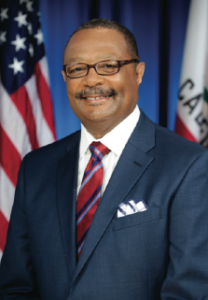
Assemblymember Reggie Jones-Sawyer
Unlike most school safety legislation introduced after the Newtown shootings, which called for increased security measures and beefing up school police forces, a bill by one California assemblyman takes a different tack: It seeks to limit the police role on school campuses.
Concerned about an overreaction to the shootings, Assemblymember Reggie Jones-Sawyer, D-Los Angeles, introduced Assembly Bill 549, which would encourage school districts to clarify the roles of school police, limiting them to handling dangerous or physically violent situations. The legislation calls for the roles of counselors, administrators, teachers and police to be outlined in school districts’ safety plans.
Jones-Sawyer’s bill has been sponsored by groups such as The Labor Community Strategy Center and the Youth Justice Coalition, both based in Los Angeles, and the national Children’s Defense Fund. These groups advocate moving away from zero-tolerance discipline policies toward dealing with the root causes of bad behavior. More counselors, not more police, are what is needed, they say.
Many schools, particularly high schools, have full-time police on campus. Often it is not clear when a misbehaving student crosses the line into criminal activity. But if police do get involved in routine disciplinary matters, students are more likely to end up in the juvenile justice system than if the issue were handled by a counselor or administrator, advocates say.
“After the Sandy Hook shootings, we wanted to get ahead of some of the more harmful proposals,” said Zoe Rawson, a spokesperson for the Community Rights Campaign, which is part of the The Labor Community Strategy Center.
In an article on the website of the Center for Public Integrity, an investigative news organization, Jones-Sawyer explains why he introduced the bill.
“This is not anti-police. I do believe there is a role for public safety on campuses,” he said. “But before we get the guns and guards out, let’s get some mental health (care) in there for students.”
“There should be guidelines for when you don’t need police involved in discipline,” he said.
However, the bill has been substantially changed by the Assembly Appropriations Committee and has met with resistance from the Association of California School Administrators. Laura Preston, a lobbyist with the group, says the bill limits the decision-making ability of administrators and that the language outlining police roles does not belong in school safety plans, which describe what should occur during an emergency.
The original bill would have required districts to rely on more positive approaches to discipline, such as restorative justice, and outline specific instances, such as dangerous situations, in which police could become involved in student cases. However, that requirement was amended in the Appropriations Committee before being heard on the Assembly floor. With the changes, the bill, which passed the Assembly on a 71-0 vote on Wednesday, now “would encourage comprehensive school safety plans to include clear guidelines” for the roles of counselors, administrators, teachers, school police and local police.
Jones-Sawyer’s legislative director, Stephanie Burri, said she hopes to work with state senators to reintroduce some of the language that was cut. “We’re trying not to be confrontational,” she said. “We want to take it out of the conjecture about law enforcement being bad. We want to clarify the roles of different folks (police and administrators).”
Braeden Weygandt, legislative analyst with Warner & Pank, a consulting group that represents the California Sheriff’s Association, said the association has taken no position on AB 549. John Lovell, lobbyist for the California Police Chiefs Association, did not return messages requesting the association’s position on the bill.
The bill may not seem important to those living in communities where police are present only when they have been called for help. But students who live in crime- and gang-ridden neighborhoods look to school as a place to escape the violence and police presence, one advocate said.
Community organizer Carlos “Elmo” Gomez
Carlos “Elmo” Gomez is an organizer with the Community Rights Campaign. He recalls his first high school in Los Angeles, which had a heavy police presence. Students, who were regularly pulled over and questioned by police in their neighborhood, did their best to avoid the school police, he said.
“You would not go to them if something is wrong, even if it’s life threatening,” he said.
Looking back, he said, “it felt like we were under occupation because it was not just my school that was heavily policed, it was the community.” If students got in a fight, police got involved and the situation became a criminal one, he said.
When Gomez was shot at during school, he had a pretty good idea of who had done it, but he knew if he told police his suspicions, it would have put him, his family and his friends at risk in his neighborhood. So he remained quiet. “They should have had intervention support, should have had peace builders,” he said. The bullets left three holes in his shirt sleeve, but neither he nor anyone else was injured.
After the shooting, Gomez was transferred to Central High School in Los Angeles, where the atmosphere was very different. “They had new teachers, new guidelines, a new system,” he said. “They had gardens and taught in a creative way.”
More importantly, there were no police on the campus even though Central was also located in a community with high violence. He remembers a policeman knocking on the door of his classroom, asking to speak to one of the students. The teacher told the policeman that no guns were allowed on campus, including his, and that he needed to talk to the student after school. The teacher then shut the door.
Gomez felt a lot safer at Central High than he had at his previous school. “I have seen that police officers do not make schools safer,” he said. “It’s time to take a different approach.”
To get more reports like this one, click here to sign up for EdSource’s no-cost daily email on latest developments in education.